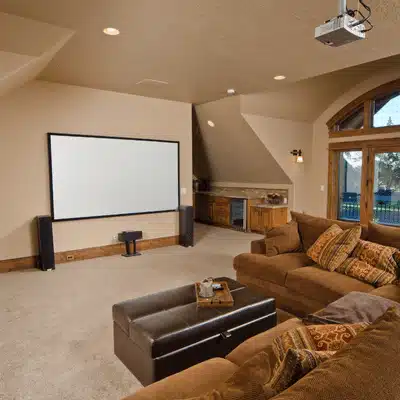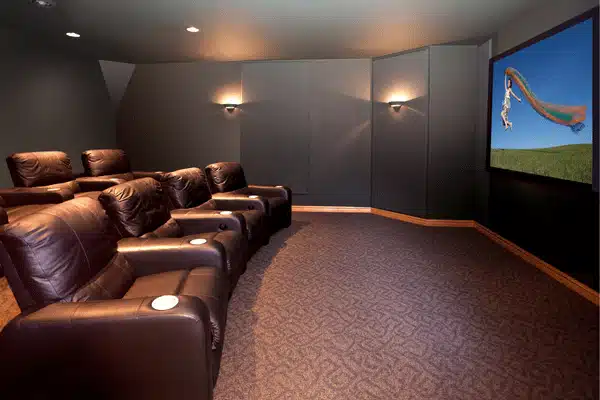Setting up a home theater system can transform your movie nights from ordinary to extraordinary. Whether you’re planning a dedicated theater room or upgrading your living room setup, the right system creates an immersive viewing experience that rivals commercial cinemas.
The key lies in matching your home theater system to your specific space, needs, and budget. This guide walks you through every decision, from room size considerations to future-proof technology choices.
Start With Your Space

Your room determines everything else about your system. Room size directly affects which speakers work best and how much power output you need from your receiver.
Small rooms (under 200 square feet) work well with compact bookshelf speakers and moderate amplification. Large spaces demand floorstanding speakers or additional amplification to fill the room properly.
Consider your acoustics too. Hard surfaces like tile floors and bare walls create echoes that muddy sound quality. Soft furnishings, carpets, and curtains help control reflections and improve your listening experience.
Speaker placement matters enormously. Your center channel should sit directly above or below your display at ear level. Front left and right speakers should angle slightly toward your main seating position. Surround sound speakers work best when placed to the sides or slightly behind listeners.
Set Your Budget Wisely
Home theater systems range from a few hundred to tens of thousands of dollars. Setting a realistic price range helps you focus on systems that deliver the best value for your situation.
Entry-level systems ($500-$1500) typically include a basic receiver with 5.1 surround sound capability and a matching speaker package. These systems provide dramatic improvement over TV speakers while keeping costs manageable.
Mid-range setups ($1500-$5000) offer better sound quality, more connectivity options, and features like room calibration. You get higher power output, better frequency response, and more flexibility for future upgrades.
Premium systems ($5000+) deliver reference-quality performance with high-end speakers, powerful amplification, and advanced audio processing. These make sense for dedicated theater rooms where performance takes priority over cost.
Choose Your Surround Sound Configuration

Surround sound systems use numbered designations like 5.1 or 7.1. The first number indicates main speakers, while the second represents subwoofers.
A 5.1 system includes front left, front right, center channel, two surround speakers, and one subwoofer. This configuration works perfectly for most rooms and provides convincing surround effects.
7.1 systems add two more speakers for enhanced immersion in larger spaces. Dolby Atmos systems like 5.1.2 or 7.1.4 include overhead speakers that create a three-dimensional soundstage with effects that move above you.
Your subwoofer handles low frequencies that create impact and rumble. Quality bass response makes explosions feel real and music sound full. Larger rooms need bigger subwoofers or multiple units for even coverage.
Select the Right Receiver
Your receiver serves as mission control, powering speakers and routing signals between sources. Power output should match or exceed your speaker requirements, especially in larger rooms.
Modern receivers include room calibration systems that automatically adjust settings for your space. These room correction technologies measure your speakers using an included microphone, then optimize levels and timing for better sound quality.
Look for sufficient HDMI inputs to connect all your sources. Gaming consoles, streaming devices, and Blu-ray players all need connections. Audio inputs like optical and analog connections accommodate older sources.
Audio processing capabilities determine which formats your system supports. Ensure compatibility with Dolby Atmos, DTS:X, and other modern audio formats you want to enjoy.
The user interface and remote control affect daily enjoyment. Complex systems become frustrating if they’re difficult to operate. Many newer receivers include smartphone apps that simplify control and setup process.
Consider Display Technology

Your display shapes picture quality, video quality, and the viewing experience. Picking one with good brand reputation in your price range matters. Video technology has advanced rapidly, with 4K HDR now the home theater standard.
Large TVs (65-85 inches) suit most living rooms and stay bright for daytime viewing; good video quality supports dialogue clarity and audio quality when a receiver drives them. Projectors give cinema size but need controlled lighting.
Video processing features optimize picture quality from various sources, improving compatibility and making the user interface feel smooth. Good upscaling makes older content look better on 4K displays.
Connectivity matters. HDMI 2.1 video inputs handle high-frame-rate gaming and future video sources. eARC lets TV apps send rich sound to your receiver, which switches audio sources and uses room correction, making that receiver the system hub.
Think About Future-Proofing
Future-proofing protects your investment as technology evolves. Choose receivers with extra channels you can use later for Atmos upgrades. Ensure HDMI inputs support current and emerging video standards for the best video quality.
Brand reputation indicates long-term receiver reliability and customer support. Established manufacturers typically provide better warranties and service when problems arise.
Versatility keeps your system relevant as your needs change. Systems that handle music playback, gaming, and movies well serve multiple purposes throughout their lifespan.
Modern audio processing and room calibration features often receive updates through firmware, extending your system’s capabilities over time with your chosen receiver.
Installation and Setup

Professional installation ensures optimal performance, especially for complex systems or dedicated theater rooms. Installers handle speaker placement, wiring, room calibration, and system programming.
DIY installation saves money but requires time and patience. Ease of use during setup varies significantly between manufacturers. Some receivers include helpful wizards that guide you through the setup process.
Room correction systems simplify optimization but still require proper initial setup. Take time to position speakers correctly before running calibration routines.
Make Your Decision
The best home theater system balances performance, budget, and ease of use for your specific situation. Sound quality and listening experience should be your primary goals, followed by connectivity options and future-proofing features.
Don’t compromise on the center channel speaker, as it handles most movie dialogue. Invest in a quality subwoofer for satisfying bass response. Choose a receiver with sufficient power output and modern audio formats.
Consider your room size, acoustics, and viewing experience goals throughout the selection process. The right system creates years of entertainment enjoyment.
Ready to transform your space? Start with a clear budget and room assessment, then choose components that work together seamlessly. Your perfect home theater awaits.


